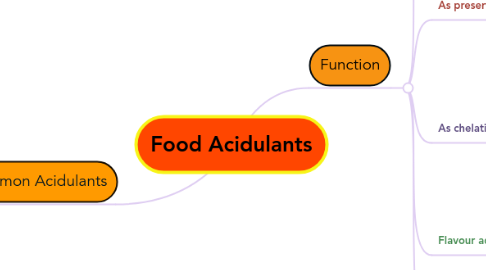
1. Common Acidulants
1.1. Acetic acid
1.1.1. Gives dinstinctive vinegar note
1.2. Fumaric acid
1.2.1. Lingering taste, and persistent sourness with dryness
1.2.2. Is the least solubility and is more sour
1.2.3. Helps in acid-coated candy
1.3. Malic acid
1.3.1. Can mask some flavors and persistents to sourness
1.3.2. Work well with high intensity sweeteners
1.4. Tartaric acid
1.4.1. Grape flavor
1.4.2. Dissipates quickly
1.4.3. Not suitable in calcium-fortified beverages
1.5. Citric acid
1.5.1. Citrus flavor
1.5.2. Has highest solubility and the strongest chelating agent
1.5.3. Dissipates quickly
1.6. Lactic acid
1.6.1. Good creamy flavor with fruit note
1.6.2. Used in dairy and fruit beverages
1.7. Phosphoric acid
1.7.1. Low impact in flavor
1.7.2. Cola flavor
2. Function
2.1. pH control agent
2.1.1. To obtain certain pH range
2.1.2. Retard enzymatic browning in fruits and vegetables
2.1.3. Maintain acidic pH and tartness of carbonated beverages
2.1.4. Buffering capacity
2.1.4.1. Maintain acidic fermentation process
2.1.4.2. Provide protection from pH dependant effects
2.2. As preservatives
2.2.1. Enhances effectiveness of heat sterilization
2.2.2. Give antimicrobial effects of solutes
2.2.3. Acts as antibrowning agents
2.3. As chelating agents/ Anti-oxidants synergist
2.3.1. Chelation: Ability to form ring structures with metal ions
2.3.2. Sequestration: Formation of a stable, water-soluble chelate
2.3.3. Used as synergists for anti-oxidants in the preservation of fats and oils
2.4. Flavour adjuncts
2.4.1. Modifies or enhance food flavours
2.4.2. Add the tartness required to balance excessive sweetness
2.5. Control of gelation and coagulation
2.5.1. Provide precise pH control for protein coagulation
2.5.2. Adjust pH 2.5-3.5 for gelling of high methoxy pectin
